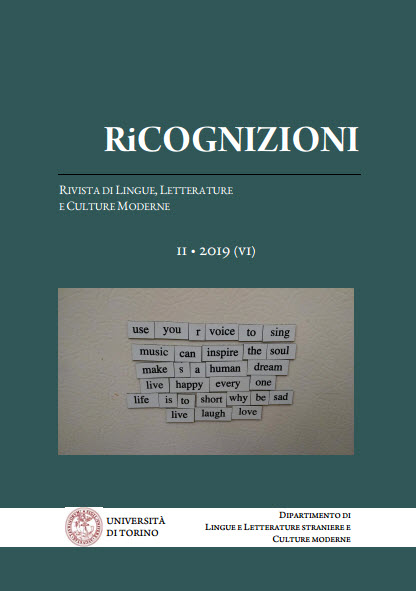STRUCTURE PROSODIQUE ET DICTION POÉTIQUE
DOI:
https://doi.org/10.13135/2384-8987/3292Parole chiave:
intonation, prosodic structure, stress group, brain waves.Abstract
Speech styles are particularly characterized by prosodic features, such as rhythm, melody, intensity or vowel quality, which indicate to the listener emotions, attitudes, sociogeographic origin of the speaker. Whatever the speech style, there are some unsuspected rules that are always applied, linked to specific cognitive properties of the brain. Among these, the necessity to segment speech units in chunks called stress groups and assemble these groups into a prosodic structure. Both stress groups duration and their hierarchical organization into a structure are constrained by theta and delta brain waves timing properties. Examples of these limits are illustrated in acoustic analysis of poetic diction showing that whatever the style adopted by readers, cognitive constrains are always observed.
Riferimenti bibliografici
Acheson D. J. and Maryellen C. MacDonald (2009) Verbal Working Memory and Language Production: Common Approaches to the Serial Ordering of Verbal Information, Psychol Bull. 2009 January; 135(1): 50–68.
Artaud, A. (1947) https://www.youtube.com/watch?v=oiScQ2wG3WU
Bally, Ch. (1944) Linguistique générale et linguistique française, Berne : Francke,
Delattre P. (1966) Les dix intonations de base du français, French Review 40, 1966, 1-14.
Ghitza, Oded (2011) Linking speech perception and neurophysiology: speech decoding guided by cascaded oscillators locked to the input rhythm, Frontiers in Psychol. 2, 130.
Léon, Pierre (1993) Précis de phonostylistique : parole et expressivité, Paris : Nathan Université, Série « linguistique », 1993
Martin Ph. (2014) Spontaneous speech corpus data validates prosodic constraints, Proceedings of the 6th conference on speech prosody, Campbell, Gibbon, and Hirst (eds.), 2014, 525-529.
Martin, Ph. (2013) Émotions et structure prosodique : qui domine qui ?, Cartographie des émotions, F. Baider et G. Cislaru éd., Paris : Presses universitaires de la Sorbonne.
Nowak, Paul (2012) Speed reading tips: 5 ways to minimize subvocalization, http://www.irisreading.com/speed-reading/speed-reading-tips-5-ways-to-minimize-subvocalization/
Martin Ph. (2018) Intonation, structure prosodique et ondes cérébrales, London : ISTE, 322 p.
Rossi, M. Le seuil de glissando ou seuil de perception des variations tonales pour la parole. Phonetica. n° 23, 1971, 1-33.
Quercia P. (2010) Ocular movements and reading: a review, J. Fr. Ophtalmologie, 33 (6): 416-423.
WinPitch (2019) Logiciel d’analyse de la parole. www.winpitch.com
Wheaton College (2019) (https://wheatoncollege.edu/vive-voix/titres/lalbatros/).
##submission.downloads##
##submission.additionalFiles##
Pubblicato
Come citare
Fascicolo
Sezione
Licenza
Gli autori che pubblicano su questa rivista accettano le seguenti condizioni:- Gli autori mantengono i diritti sulla loro opera e cedono alla rivista il diritto di prima pubblicazione dell'opera, contemporaneamente licenziata sotto una Licenza Creative Commons - Attribuzione che permette ad altri di condividere l'opera indicando la paternità intellettuale e la prima pubblicazione su questa rivista.
- Gli autori possono aderire ad altri accordi di licenza non esclusiva per la distribuzione della versione dell'opera pubblicata (es. depositarla in un archivio istituzionale o pubblicarla in una monografia), a patto di indicare che la prima pubblicazione è avvenuta su questa rivista.
- Gli autori possono diffondere la loro opera online (es. in repository istituzionali o nel loro sito web) prima e durante il processo di submission, poiché può portare a scambi produttivi e aumentare le citazioni dell'opera pubblicata (Vedi The Effect of Open Access).








